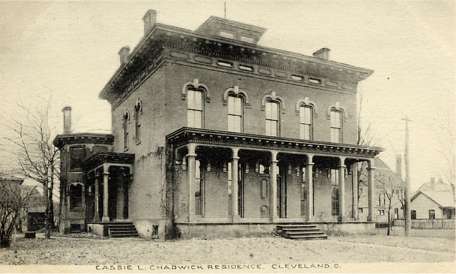
Cassie Chadwick (1857-1907)
Most criminal profilers in America agree that the success of a good con is the perpetrator of the cons ability to think on their feet, adjust to all situations in an instant and be on a constant vigil for the next opportunity. Elizabeth Bigley, a con woman since the age of 11, did not perfect her abilities until she was nearly 40 years old and her biggest con goes down in America’s strange history as one of the most elaborate and successful cons ever perpetrated in America.
At the age of 13, Elizabeth Bigley was first arrested for forgery, in Ontario, Canada. She had opened a bank account with very little money and began writing bad checks to businesses in Woodstock, Ontario. The courts determined that the young Elizabeth was mentally troubled and released her to her father. She made her way to Cleveland, Ohio in 1875, to be with her newly married sister. Elizabeth was in need of employment so she set up shop as a fortune teller under the name of Madame Lydia de Vere. Over the next 14 years she was married twice, first to Dr. Wallace Springsteen who quickly discovered her criminal behavior and filed for divorce. She next married a farmer named John Scott, however farm life did not suit Elizabeth and the couple was divorced four years later.
Elizabeth returned to Cleveland under the name of Cassie Hoover and opened a brothel on the west side of the city. To mask the criminal activities of her establishment, Elizabeth posted her address, in Cleveland’s City Directory, as a boarding house for single women. There, in 1897, Elizabeth met and later married a wealthy doctor, Leroy Chadwick. Cassie Chadwick was not well received within Cleveland’s elite but that did not stop her from trying to fit in. She was known to spend large amounts of her husband’s money on spending spree’s and throwing lavish parties to impress the socialites who lived along Euclid Avenue, Cleveland’s “Millionaire Row”. Shortly after their marriage, Elizabeth began to set the stage or her biggest con when she revealed to her new husband that she was the illegitimate daughter of industrialist and philanthropist, Andrew Carnegie. Dr. Chadwick took his new bride on a buying trip to New York City where Elizabeth, with the help of an Ohio banker who was acquainted with her husband, made her way to the home Carnegie. When she returned to the honeymoon suite in the Holland House hotel, she was in possession of a promissory note for two million dollars, endorsed by Carnegie, which Elizabeth claimed was a payoff to keep his illegitimate daughter quiet and out of the newspapers of the era. She furthermore claimed that she was in possession of ten million dollars worth of promissory notes.

Cleveland Mansion of Cassie Chadwick
Upon her return to Cleveland, Elizabeth entered the Citizens Bank of Oberlin, Ohio seeking a loan from the unsuspecting bank president. Using the promissory note and the well respected Chadwick name, she secured a loan for $200,000. Over the next eight years Elizabeth, borrowing from bank after bank, as well as individuals, amassed and spent a fortune estimated to be nearly $10,000,000 (approximately $85,000,000 in 21st century dollars). Her newfound wealth shot her to the top of the social scene in Cleveland and she was dubbed, “The Queen of Ohio”, by the Cleveland newspapers. The banks and individuals who gave loans to Elizabeth never thought to question the promissory notes that she was providing. In many cases she would ceremoniously place forged promissory notes in safety deposit boxes of the banks that she was bilking out of hundreds of thousands.
The con came to an end in November of 1904 when Boston banker and millionaire, Herbert Newton arrived in Cleveland seeking payment for a $190,000 loan which he had given her on a $1,000,000 promissory note. Elizabeth claimed that she could not repay Newton any of the money because her holdings were being held up by a Cleveland bank. Newton, with a police escort, entered the Wade Park bank that she had named however the bank was devoid of records concerning Elizabeth’s claims. Elizabeth was arrested in New York in early December, 1904. At the time of her arrest, she had amassed $5,000,000 worth of debt in several states but because she had defrauded banks that were federally insured, she was charged with seven counts of defrauding the government. Within the charges was one charge levied against her regarding her loans from the Citizens Bank of Oberlin which totaled $800,000 and, upon the discovery of Elizabeth’s con, had driven the institution into bankruptcy.
Elizabeth Bigley, aka Cassie Chadwick was tried and convicted of multiple con related crimes, including theft and defrauding the government, in two different trials. She was sentenced to 14 years in the women’s facility at Ohio State Penitentiary in Columbus, Ohio. Her federal trial was a media sensation that filled the courtroom with reporters, curios spectators, victims of Elizabeth’s bank and individual cons and Andrew Carnegie, the man whose name was used to bilk a total of $10,000,000. When Carnegie was asked about Elizabeth’s use of his name to con millions of dollars from individuals and banks, he stated that he had not issued a promissory note in twenty years and that the crimes may not have happened if they had asked him.
Elizabeth Bigley died in prison two years into her 14 year sentence, however her time in prison was not as dreary and miserable as most would think. Due to her popularity, Elizabeth was allowed to have some of her personal belongings in her jail cell, including custom tailored dresses, shoes, furs, lavish furniture and steady access to any newspaper writers who wished to talk to her.
{fcomment}
